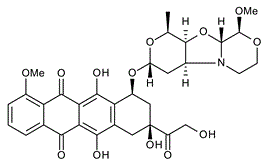This product is for research use only, not for human use. We do not sell to patients.

| Size | Price | Stock |
|---|---|---|
| 100mg | $3600 | In Stock |
| 200mg | $5400 | In Stock |
| 500mg | $8425 | In Stock |
Cat #: V4152 CAS #: 202350-68-3 Purity ≥ 98%
Description: PNU-159682 (PNU) is a highly potent metabolite of the anthracycline nemorubicin (MMDX) with excellent cytotoxicity. PNU-159682 was remarkably more cytotoxic than MMDX and doxorubicin in vitro, and was effective in the two in vivo tumor models tested, i.e., disseminated murine L1210 leukemia and MX-1 human mammary carcinoma xenografts.
Publications Citing InvivoChem Products
Product Promise

- Physicochemical and Storage Information
- Protocol
- Related Biological Data
- Stock Solution Preparation
- Quality Control Documentation
| Molecular Weight (MW) | 641.62 |
|---|---|
| Molecular Formula | C32H35NO13 |
| CAS No. | 202350-68-3 |
| Storage | -20℃ for 3 years in powder formr |
| -80℃ for 2 years in solvent | |
| SMILES Code | O=C(C1=C(C2=C(C(O)=C1C3)C[C@@](O)(C(CO)=O)C[C@@H]2O[C@@H]4O[C@H]([C@H]5O[C@@H]6[C@@H](OC)OCCN6[C@H]5C4)C)O)C7=C3C=CC=C7OC |
| Synonyms | metabolite of nemorubicin (MMDX); PNU159682; PNU-159682; PNU 159682; |
| Protocol | In Vitro | PNU-159682 (0-500 nM; exposed to the compounds for 1 hour and then cultured in compound-free medium for 72 hours) has cytotoxic effects on human tumor cell lines in a sulforhodamine B assay. The IC70 values are 0.577 nM, 0.39 nM, 0.128 nM, and 0.081 nM, 0.086 nM and 0.075 nM for HT-29, A2780, DU145, EM-2, Jurkat and CEM cells, respectively. It against human tumor cell lines with IC70 in the ranging 68 nM-578 nM and 181 nM-1717 nM towards MMDX and doxorubicin, respectively. PNU-159682 is more potent than MMAE on NHL cell lines. In a cell viability assay, PNU-159682 is against BJAB.Luc, Granta-519, SuDHL4.Luc, and WSU-DLCL2 with IC50 values of 0.10 nM, 0.020 nM, 0.055 nM, and 0.1 nM, respectively. While MMAE is against BJAB.Luc, Granta-519, SuDHL4.Luc, and WSU-DLCL2 with IC50 values of 0.54 nM, 0.25 nM, 1.19 nM and 0.25 nM, respectively. PNU-159682 is thousands of times more cytotoxic than doxorubicin and can be used to develop a new class of ADCs. PNU159682 to anti-CD22 antibody (anti-CD22-NMS249) exhibits strong anti-tumor effects in vitro. Anti-CD22-NMS249 (PNU159682 to anti-CD22 antibody) is active in in vitro viability assays of NHL cell lines and is 2 to 20 fold more potent than pinatuzumab vedotin, the ADC anti-CD22-NMS249 is against BJAB.Luc, Granta-519, SuDHL4.Luc, and WSU-DLCL2 with IC50 values of 0.058 nM, 0.030 nM, 0.0221 nM, and 0.01 nM, respectively. PNU-159682 (100 μM) weakly inhibits topoisomerase II unknotting activity. PNU-159682 shows cytotoxic effect on CAIX-expressing SKRC-52 cells with IC50 of 25 nM. |
|---|---|---|
| In Vivo | PNU-159682 (single-dose; i.v.15 μg/kg) is a maximum tolerated dose in murine L1210 leukemia model. PNU-159682 shows an improved antitumor activity in vivo. The antitumor effect of PNU-159682 (increase in life span=29%) is comparable to that afforded by 90 μg/kg MMDX (increase in life=36%). PNU-159682 (i.v. 4 μg/kg; q7dx3; 40 days) has a therapeutic response in MX-1 human mammary carcinoma mice. What’s more, from day 39, four out of seven mice receiving PNU-159682 exhibits complete tumor regression. PNU-159682 is more cytotoxic than doxorubicin and can be used to develop a new class of ADCs. PNU159682 to anti-CD22 antibody (anti-CD22-NMS249) exhibits strong anti-tumor effects in vivo. ADC dose (anti-CD22-NMS249; 50 µg/m2 conjugated PNU-159682) is well tolerated in mice and results in less than 10% weight loss. In the BJAB.Luc model the efficacy of antiCD22-NMS249 (single dose; 2 mg/kg) is similar to anti-CD22-vc-MMAE. At 2 mg/kg dosage, antiCD22-NMS249 gives complete remission of the tumors (NMS249: 110-134%TGI vs. vc-MMAE: 114-143%TGI). Additionally, a single dose of antiCD22-NMS249 at 2 mg/kg results in tumor stasis for three weeks. | |
| Animal model | Four- to six-week-old female CD-1 athymic nude mice with MX-1 tumor fragment | |
| Dosages | 4 μg/kg | |
| Administration | Intravenous injection; q7dx3; 40 days |
| Solvent volume to be added | Mass (the weight of a compound) | |||
|---|---|---|---|---|
| Mother liquor concentration | 1mg | 5mg | 10mg | 20mg |
| 1mM | 1.5586 mL | 7.7928 mL | 15.5855 mL | 31.1711 mL |
| 5mM | 0.3117 mL | 1.5586 mL | 3.1171 mL | 6.2342 mL |
| 10mM | 0.1559 mL | 0.7793 mL | 1.5586 mL | 3.1171 mL |
| 20mM | 0.0779 mL | 0.3896 mL | 0.7793 mL | 1.5586 mL |
This equation is commonly abbreviated as: C1 V1 = C2 V2
- (1) Please be sure that the solution is clear before the addition of next solvent. Dissolution methods like vortex, ultrasound or warming and heat may be used to aid dissolving.
- (2) Be sure to add the solvent(s) in order.




































